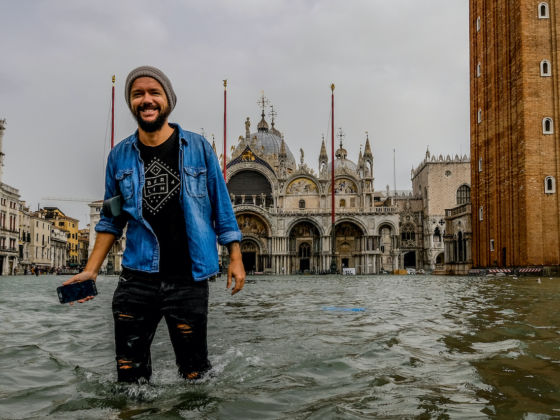On the evening of Tuesday, November 12, the northeastern Italian city of Venice was extensively flooded following the highest tide the city has seen since 1966. Water levels reached 6.1 feet, causing around 85 percent of the city to be underwater. But as Venice was “on its knees” to quote Mayor Luigi Brugnaro, tourists gambled and snapped selfies in flooded St. Mark’s Square, seemingly apathetic to the destruction around them.


The lagoon city of Venice is prone to flooding during high tides, particularly when accompanied by winds, which drive the water into the lagoon. Flooding has been exacerbated over the years by rising sea levels. The city is also gradually sinking as it sits on wooden piles driven into the lagoon bed, a foundation which is subsiding due to excavation works in the area and the waves created by the passage of cruise ships. The high tide, locally known as acqua alta, of the night of November 12 was exceptional, in part due to the strong driving winds. It caused the deaths of four people, as well as hundreds of millions of euros’ worth of damage. The flooding meant schools were closed, shops were forced to throw away huge amounts of stock, and historic buildings suffered irreparable damage. The following days did nothing to ease the problem, as further peaks in the tide hindered the cleanup process and caused St. Mark’s Square to be closed as a precaution.
Following this devastating event, Venetians have come out saying they feel betrayed and abandoned by the authorities, whose project to protect the city from high tides is still not in operation. The MOSE project should see a protective series of flood barriers in the lagoon, which would prevent high tides from entering and flooding the city and other islands. However, the barrier system designed in 1984 is still not in action and is billions of euros over budget due to both a corruption scandal and technical issues. There is anger too that, despite frequent protests from residents and environmentalists, channels have been excavated in the lagoon for cruise ships which have worsened the effect of the tides.
But while Venetians began the long and painful process of cleanup and damage assessment, the reaction of many tourists to the situation has been a case of rubbing salt in the wound. Outside St. Mark’s Basilica, whose Byzantine treasures lay under several feet of water, tourists gathered to snap their “I was here” photo. As Italian newspaper Il Gazzettino reported, this all became too much for Pierpaolo Campostrini, the procurator of the ancient basilica, who burst out emotionally at the tourists (in English), “This is not a good day for us Venetians. We’re not happy to have tourists here at this moment.” Smiles faded and the tourists scattered, but they were quickly replaced by others oblivious to the anger of residents at their attitude.
Acqua alta is certainly part of Venice, but how it has come to be characterized as part of the city’s charm is bewildering to residents. The Guardian reported that two visitors from Liverpool who, despite seeing a rat floating in the water, said, “I think the water makes the city even more magical.” Visitors seem unconcerned that dramatic high tides mean public water bus services can’t run, mail can’t be delivered, ambulance workers have to wade through knee-deep water to make rescues, and the elderly and those with disabilities are essentially imprisoned in their homes. Those with ground-floor shops or houses struggle with damage to goods and property, and cultural and historic treasures are in danger.
But when the high tide reaches levels such as that of last week, it becomes a natural disaster. While few tourists would take selfies in front of houses succumbing to a wildfire, Venice is somehow not treated with the same sensitivity. As Fabio Vianello of Italian travel publication 2night put it, “To the man swimming in St. Mark’s Square during high water: bathing in Piazza San Marco at this tragic times [sic], is like using the embers of a burning house to have a barbeque.” Italian publication Il Giornale reported that tourists queued up in front of an overturned motorboat in an alley to be able to take a photo with the damaged vessel. It would seem that rather than putting tourists off coming to the city, the exceptionally high tide worked as a twisted form of publicity and attracted large crowds over the following weekend. Tourists were seen queuing on the duckboards in St. Mark’s Square, equipped with cameras and video recorders.
Throwing the callous reaction of tourists yet further into perspective were the reports of school children and community groups who were volunteering to help shop and business owners to clear the debris on their premises. Something has gone very wrong when tourists can treat a natural disaster as an opportunity for social media attention, despite seeing residents, including young children, carrying bag after bag of refuse and destroyed possessions from houses and shops. In fact, tourists’ disinterest was not only seen as disrespectful by Venetians but also a nuisance as they clogged up streets hampering workers.
Venice has frequently had to suffer impertinent behavior by tourists, but their insensitivity to the recent disaster suggests there’s a real problem in how Venice is perceived by visitors. As Alberto Toso Fei, reporting for Il Gazzettino, put it, Venetians live in “total symbiosis with the city,” and they are hurt when the city is hurt. Tourists, on the other hand, seem able to revel unrestrained in the calamity like it’s an attraction at a theme park.